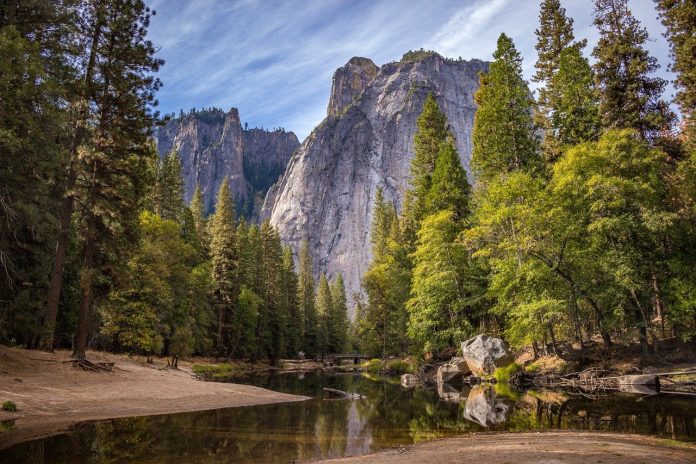Theodore Roosevelt, the first new president in the 20th century and the 26th overall, is one of the most recognized individuals in American history. This was especially true after he spoke in his jerky voice at the Minnesota State Fair in 1901: “speak softly and carry a big stick.”
The personality traits that he exhibited were what the average American admired. He had a body that stretched 5 feet 10 inches, with a round ruddy face covered by wavy brown hair, parted in the middle, bushy sideburns and a mouth full of teeth. Spectacles covered the near-sighted blue eyes; he weighed 210 pounds, and his general bellicose airs made him a cartoonist’s delight.
His jaunt through life left a trail as a rancher, soldier, writer, politician, environmentalist and naturalist. It is in the naturalist field that “Teddy” secured a lasting legacy of preserving the natural beauty of America.
Roosevelt’s lifelong love of the outdoors, the animals and the natural resources propelled him to foster the conservation of America’s landscape. During his presidency, millions of acres of wilderness were protected and saved for future generations.
Conference on conservation
But it was the Inland Waterways Commission report of 1907 that stressed the interrelation of all conservation problems that committed Roosevelt to call a national conference on conservation.
Few gatherings in the White House have ever been as charged with expectation or as crowded with dignitaries as the White House Conference on Conservation, May 13, 1908. The audience in the East Room included the cabinet, the Supreme Court justices, leader of the Democratic party, the governors of 38 states, and distinguished scientists, scholars and other men of public affairs.
The conference was an epochal event, and for Roosevelt, it was the culmination of seven years of effort on behalf of conservation and the beginning of changing public opinion about saving from destruction our natural resources.
Time for change
Standing on a raised platform, Roosevelt, the hero of the Spanish-American “Splendid Little War,” lectured to the conference: “the time has come for a change. As a people we have the right and the duty, second to none other but the right and duty of obeying the moral law, of requiring and doing justice, to protect ourselves and our children against the wasteful development of our natural resources.”
For three days, he kept the conference in session, and in the end, the governors agreed with Roosevelt that the time had come to take a stand.
In a landmark declaration that was significant not only for conservation but also for a new federal-state relationship, the governors acquiesced unanimously and pledged “that the sources of national wealth existed for the benefit of the people and that monopoly should not be tolerated.”
From the conference came support for protection of the navigable streams and rivers, control of forest fires, regulations for cutting timber and granting of surface title for mineral below the surface.
Federal commission
A month after the conference, Roosevelt established the Federal Commission on the Conservation of Natural Resources, headed by Gifford Pinchot, the ex-governor of Pennsylvania and the president’s chief advisor on conservation matters.
The commission was divided into four divisions of water, forest, land and mineral resources. Within a year, 41 state conservation departments had joined the effort.
When Roosevelt vacated the presidency in 1909, the nation lost the greatest single advocate of conservation it had ever had to that time in history. Pinchot carried on the fight, but eventually he fell victim to a less sympathetic President William H. Taft, as well as to his own agitating zeal.
The White House Conference on Conservation was the last grand gesture of Roosevelt’s conservation program and it served to keep the idea of conservation alive until his fifth cousin Franklin D. Roosevelt again championed specific legislation to protect the nation’s resources.
Early beginnings
Teddy Roosevelt’s commitment to conservation began when he was 8 years old and discovered a lifeless seal. The romance of natural science was like a burning lightbulb inviting curiosity. He liked birds and was soon hunting, stuffing, starting a museum and reading ornithology. His studies at Harvard, ranching, hunting and museum naturalism developed Roosevelt into a conservationist of the highest order.
His first commitment to conservation as president began when he signed the Newlands Reclamation Act of 1902, which began the government’s irrigation program in the West. The Rough Rider hero created five more national parks to bring the total number to 10.
He signed the Antiquities Act of 1906 that established 18 national memorials from California’s Muir Woods to Washington’s Mount Olympus. By executive order, Roosevelt formed 51 federal bird reserves. When Congress, sympathetic to Western lumber companies, attempted to stop his conservation program, Roosevelt set aside 125 million acres of forest and 2,565 acres for power sites.
By the time of the White House conference, the public had become aware of the problem of conservation. But the big business-oriented Congress of the 1920s refused to acquiesce in the recommendations of the conference and tried on several occasions to revoke Roosevelt’s order.
The newspapers, however, hailed the conference objective unanimously and for years they served as a reminder of the deep commitment made in the midst of the Progressive reform movement. Theodore Roosevelt’s crusade had its critics and administration attempts to circumvent it, but none could ignore it.
With the 1908 governors’ conference, the ideals of saving the nation’s conservation practices were firmly implanted in the minds of the American people and the dangerous exploitation of irreplaceable natural resources was brought under the control of the public. That’s your history!













